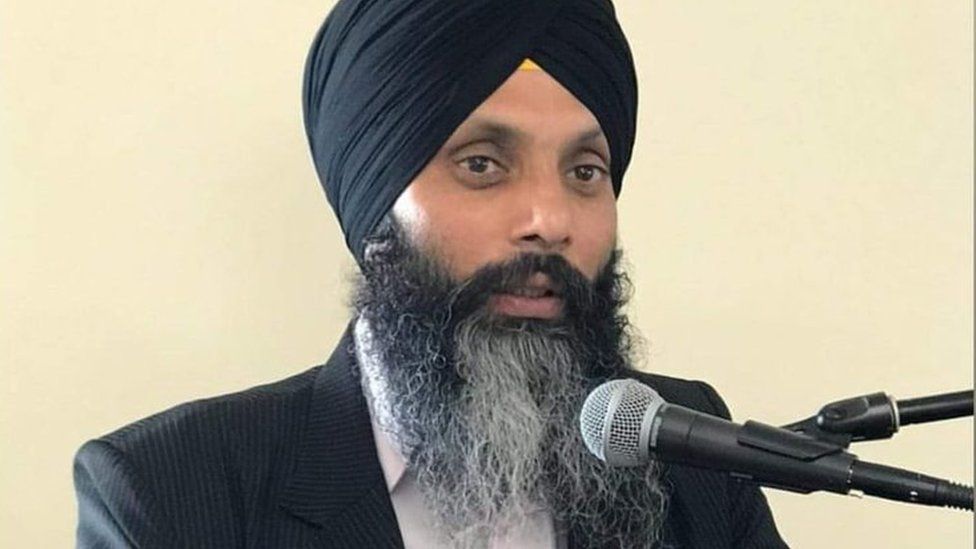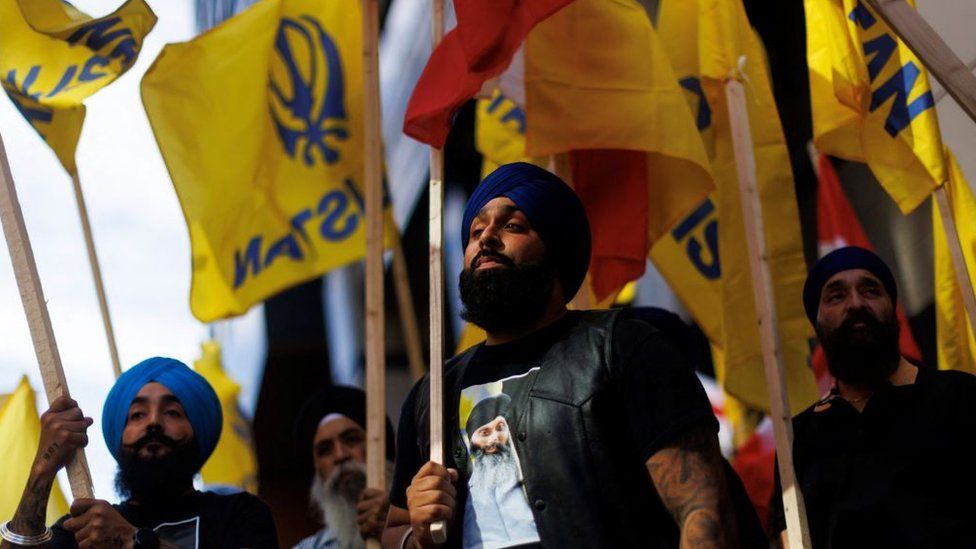What US agents knew before a Canadian Sikh leader was killed
-
Published

US prosecutors have charged an Indian man with a plot to kill at least four Sikh leaders in North America. The indictment links the case to the murder of a Canadian citizen earlier this year, and has prompted questions about what US agents knew in the days before his death.

On 18 June, Nikhil Gupta watched a video of a Canadian Sikh leader who had been shot dead in his car, his bloody body slumped over the steering wheel.
Mr Gupta then forwarded the video to a man he is accused of hiring as a hitman for another murder, in a different country. On the phone the next day, Mr Gupta told the man that the Canadian leader had been a “target”, “#4, #3” on a list.
“We have so many targets,” Mr Gupta said. “The good news is this: now no need to wait.”
Those alleged conversations were outlined in an indictment unsealed by US prosecutors on Wednesday. The US Justice Department has charged Mr Gupta with an elaborate plot to assassinate a dual US-Canadian citizen based in New York, a plot allegedly directed by an Indian government employee.
That particular scheme was thwarted. The hitman in New York who Mr Gupta allegedly agreed to pay $100,000 was in fact an undercover agent.
But the 15-page charging document also provides new details on the attack that did succeed – the fatal shooting of Hardeep Singh Nijjar in British Columbia. These details raise fresh questions about that murder on Canadian soil, about who knew what, and when.

The brazen killing of Mr Nijjar, a 45-year-old leader who campaigned to establish a Sikh state independent of India, shocked Canadians.. The murder spun into a diplomatic disaster a few months later in September, when Canada’s Prime Minister Justin Trudeau said there were “credible allegations” that India had been involved.
Mr Trudeau’s accusation – dismissed by India as “absurd” – widened a growing rift between the two countries and the prime minister faced pressure to reveal some of the evidence behind his claims. Speaking on Wednesday, Mr Trudeau said only that the US charges emphasised India’s need to take Canada’s allegations seriously.
But experts say the US indictment has added weight to his claims.
“Today’s proof goes a lot further than what Trudeau said [in September],” Stephanie Carvin, professor of international affairs at Carleton University in Ottawa, told the BBC. “This makes it clear there was a conspiracy to kill four individuals, three in Canada… The killing of Mr Nijjar was not a one-off.”
At the time of Mr Trudeau’s allegation, the public response from Canada’s closest ally seemed muted. US officials expressed concern over the incident but stopped short of either echoing Mr Trudeau’s claims or condemning India outright.
We now know the White House knew of the US investigation into the murder-for-hire plot weeks before Mr Trudeau went public after the G20 summit in India. A senior administration official confirmed that President Joe Biden had raised concerns with his Indian counterpart, Narendra Modi, at that same global meeting.
“There’s a big target in Canada”
Mr Gupta, US officials allege, was involved in international narcotics and weapons trafficking before he was recruited by an Indian government official in May 2023 to arrange the assassination. The target was not named in the indictment but is reported to be Sikh separatist leader Gurpatwant Singh Pannun, an associate of Mr Nijjar.
Mr Pannun is the general counsel for Sikhs for Justice, an organisation based in the US that supports the broader Khalistan movement, which calls for an independent homeland for Sikhs, who make up about 2% of India’s population.
The movement was at its peak in the 1980s in the state of Punjab, which witnessed several violent attacks and deaths. It lost traction after armed forces ran special operations against the movement, which is now banned in India, but supporters in the diaspora have continued their calls for a separate state.
Mr Pannun, like Mr Nijjar, has been designated a terrorist by India, charges they both denied.
For weeks, the indictment alleges, Mr Gupta tracked and monitored Mr Pannun, following orders from the Indian government employee – who described himself in communications as a “senior field officer” with training in “battle craft”.
The document reveals how US law enforcement infiltrated the alleged plot, setting him up with a phoney hitman, who was actually an undercover agent.
As the alleged murder plot moved forward, Mr Gupta alluded to a long list of targets that would follow the assassination of Mr Pannun. “More jobs, more jobs”, he said in a June phone call, cited in the indictment.
Those prospective “jobs” included cross-border operations. On 12 June, Mr Gupta told the US law enforcement source there was a “big target” in Canada.
Six days after that, on 18 June, Mr Nijjar was shot dead by two gunmen wearing dark clothes with hoods outside a Sikh temple in Surrey, British Columbia.
Watch: Trudeau accuses India in killing of Canadian Sikh
Canada’s national police force, the Royal Canadian Mounted Police, are still actively investigating Mr Nijjar’s death, and offered no comment in the wake of the US indictment. US prosecutors do not allege any of the accused plotters were involved in that crime, but claim Mr Gupta and his Indian handler discussed it in the immediate aftermath.
Mr Gupta told the Indian government employee he wished he had personally carried out the killing, according to the indictment. Soon after, he called the US law enforcement source, identifying Mr Nijjar as the potential Canadian “job” he had referenced days earlier.
“This is the guy, I send you the video,” Mr Gupta said. “Some other guy did this job.”
And, court documents suggest, Mr Nijjar’s murder seemed to spur Mr Gupta on. He told the US source that Mr Pannun’s murder should be done “quickly”. And after that was done, Mr Gupta allegedly said, they had three more “jobs” to do before the end of June – all three in Canada.
A question of ‘actionable intelligence’
The details included in Wednesday’s indictment have raised new questions about the threats to Canadians, including Mr Nijjar.
Mr Nijjar was reportedly warned by Canadian law enforcement that his life was in danger soon before he was killed. But it’s unclear how much that warning was informed by US intelligence on the threat to Canadian citizens gathered through the undercover operation.
“It strikes me as extremely unlikely that any information available to the FBI wouldn’t have been made known almost immediately to Canadian authorities,” Wesley Wark, a senior fellow at the Centre for International Governance Innovation, told the BBC. He described the Canada-US law enforcement relationship as “very tight and very close”.
The more likely story, he said, was that there was less “actionable intelligence” – details that could be reliably acted upon – in the case of Mr Nijjar compared to the case of Mr Pannun.
But why was the US able to thwart a murder plot while Canada was not?
“I think it would be too soon to assume that there was some kind of major breakdown of law enforcement or intelligence on the Canadian side in terms of trying to protect Mr Nijjar,” he said.
The reality may be scarier, Mr Wark said. The US indictment – combined with Mr Trudeau’s allegations – suggest there may have been multiple hit teams on the loose, with one able to evade detection and carry out its mission.
On Wednesday, the White House confirmed it had raised the alleged plot with the Indian government at the most senior levels, adding that Indian officials responded with “surprise and concern”. The Indian government said it had launched an investigation into security concerns raised by the US in relation to the plot.
But neither the US or India will want to undermine their budding diplomatic relationship, said Professor Carvin, the international affairs expert.
“I strongly suspect there were a lot of calls from Washington to Delhi to try and sort this out as quietly and quickly as possible,” she said.
While we wait for any diplomatic fallout, Wednesday’s revelations have already offered validation to Canadian Sikhs, said Gurpreet Singh, a Sikh journalist and radio host based in British Columbia.
“People generally feel vindicated because this is what we’ve been saying for a very long time – that the Indian government is interfering, that they’re trying to muzzle voices of dissent,” he said. “In a way, Hardeep Singh Nijjar has been vindicated posthumously.”
With reporting from Nadine Yousif
